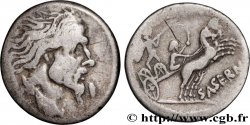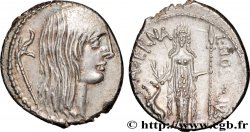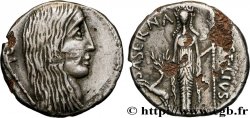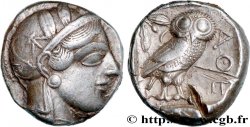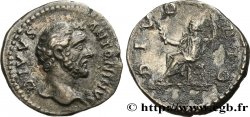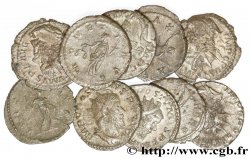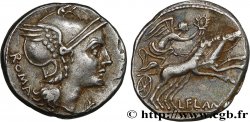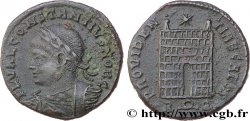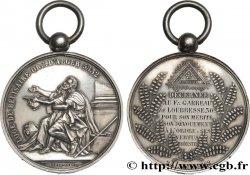Live auction - brm_426736 - HOSTILIA Denier
You must signin and be an approved bidder to bid, LOGIN TO BID. Accounts are subject to approval and the approval process takes place within 48 hours. Do not wait until the day a sale closes to register. Clicking on "BID" constitutes acceptance of the terms of use of cgb.fr private live auctions.
Bids must be placed in whole Euro amounts only. The sale will start closing at the time stated on the item description; any bids received at the site after the closing time will not be executed. Transmission times may vary and bids could be rejected if you wait until the last second. For further information check the Live auction FAQ
All winning bids are subject to a 18% buyer’s fee.
All winning bids are subject to a 18% buyer’s fee.
| Estimate : | 1 500 € |
| Price : | 815 € |
| Maximum bid : | 950 € |
| End of the sale : | 13 June 2017 14:39:18 |
| bidders : | 3 bidders |
Type : Denier
Date: 48 AC.
Mint name / Town : Roma
Metal : silver
Millesimal fineness : 950 ‰
Diameter : 17 mm
Orientation dies : 12 h.
Weight : 3,17 g.
Rarity : R2
Coments on the condition:
Exemplaire dans un état de conservation remarquable. Portrait bien venu malgré le défaut de métal sur la joue et droit complet avec le bouclier bien visible. Joli revers. Très agréable patine grise de collection ancienne
Catalogue references :
Obverse
Obverse legend : ANÉPIGRAPHE.
Obverse description : Tête barbue de guerrier gaulois à droite (Vercingétorix) ; derrière, un bouclier gaulois.
Reverse
Reverse legend : L HOSTILIVS/ SASERN.
Reverse description : Guerrier combattant dans un bige galopant à droite, conduit par un aurige, tenant les rênes de la main droite et un fouet de la main gauche ; le guerrier, nu est tourné à gauche, brandissant une javeline de la main droite et tenant un bouclier de la main gauche.
Reverse translation : “Lucius Hostilius Saserna”, (Lucius Hostilius Saserna).
Commentary
Monnaie fourrée avec deux minuscules manques d’argent sur la joue et au revers sur le cheval à gauche. Pour ce type, M. Crawford a relevé une estimation de 57 coins de droit et de 63 coins de revers. Ce type, très populaire et recherché semble plus rare dans les trésors. Seulement dix-neuf exemplaires ont été relevés par M. Crawford.
C’est le plus gaulois des deniers romains ou le plus romain des guerriers gaulois. La tête échevelée et barbue n’a rien à voir avec le buste élégant et hellénisant des statères arvernes épigraphes de Vercingétorix (LT. 3774-3778). Néanmoins, dans de nombreux ouvrages d’histoire ou de latin, c’est le visage du vaincu qui a été retenu, pour illustrer le chef gaulois, pour nous représenter l’image du chef battu par César qui devait être peu âgé et à demi-barbare afin de symboliser le combat de titan qui avait opposé les deux hommes dans la dernière phase de la Guerre des Gaules. N’oublions pas, au contraire, que le chef gaulois était âgé d’une vingtaine d’années quand il souleva la Gaule contre l’envahisseur et, n’en n’avait pas trente quand il fut étranglé dans sa prison à Rome.
Encore une fois, c’est un acteur direct de la Guerre des Gaules, Lucius Hostilius Saserna, collaborateur de J. César, qui a fait frapper ce denier, deux ans avant le quadruple Triomphe de son ami et mentor. L’exemplaire de e-MONNAIES 1 en TTB+ s’est vendu 2960€ sur un maximum à 3600€.
Filled coin with two tiny silver losses on the cheek and on the reverse on the horse on the left. For this type, M. Crawford noted an estimate of 57 obverse dies and 63 reverse dies. This type, very popular and sought after, seems rarer in treasures. Only nineteen examples were noted by M.. Crawford.
He is the most Gallic of Roman denarii or the most Roman of Gallic warriors.. The disheveled and bearded head has nothing to do with the elegant and Hellenistic bust of the Arverni epigraph staters of Vercingetorix (LT. 3774-3778). However, in many works of history or Latin, it is the face of the vanquished that has been chosen to illustrate the Gallic leader, to represent to us the image of the leader beaten by Caesar who must have been relatively old and half-barbarian in order to symbolize the titanic combat that opposed the two men in the last phase of the Gallic Wars.. Let us not forget, on the contrary, that the Gallic leader was about twenty years old when he raised Gaul against the invader and was not yet thirty when he was strangled in his prison in Rome..
Once again, it is a direct actor in the Gallic Wars, Lucius Hostilius Saserna, collaborator of J. Caesar, who had this denarius struck, two years before the quadruple Triumph of his friend and mentor. The e-MONNAIES 1 copy in TTB+ sold for €2,960 out of a maximum of €3,600.
C’est le plus gaulois des deniers romains ou le plus romain des guerriers gaulois. La tête échevelée et barbue n’a rien à voir avec le buste élégant et hellénisant des statères arvernes épigraphes de Vercingétorix (LT. 3774-3778). Néanmoins, dans de nombreux ouvrages d’histoire ou de latin, c’est le visage du vaincu qui a été retenu, pour illustrer le chef gaulois, pour nous représenter l’image du chef battu par César qui devait être peu âgé et à demi-barbare afin de symboliser le combat de titan qui avait opposé les deux hommes dans la dernière phase de la Guerre des Gaules. N’oublions pas, au contraire, que le chef gaulois était âgé d’une vingtaine d’années quand il souleva la Gaule contre l’envahisseur et, n’en n’avait pas trente quand il fut étranglé dans sa prison à Rome.
Encore une fois, c’est un acteur direct de la Guerre des Gaules, Lucius Hostilius Saserna, collaborateur de J. César, qui a fait frapper ce denier, deux ans avant le quadruple Triomphe de son ami et mentor. L’exemplaire de e-MONNAIES 1 en TTB+ s’est vendu 2960€ sur un maximum à 3600€.
Filled coin with two tiny silver losses on the cheek and on the reverse on the horse on the left. For this type, M. Crawford noted an estimate of 57 obverse dies and 63 reverse dies. This type, very popular and sought after, seems rarer in treasures. Only nineteen examples were noted by M.. Crawford.
He is the most Gallic of Roman denarii or the most Roman of Gallic warriors.. The disheveled and bearded head has nothing to do with the elegant and Hellenistic bust of the Arverni epigraph staters of Vercingetorix (LT. 3774-3778). However, in many works of history or Latin, it is the face of the vanquished that has been chosen to illustrate the Gallic leader, to represent to us the image of the leader beaten by Caesar who must have been relatively old and half-barbarian in order to symbolize the titanic combat that opposed the two men in the last phase of the Gallic Wars.. Let us not forget, on the contrary, that the Gallic leader was about twenty years old when he raised Gaul against the invader and was not yet thirty when he was strangled in his prison in Rome..
Once again, it is a direct actor in the Gallic Wars, Lucius Hostilius Saserna, collaborator of J. Caesar, who had this denarius struck, two years before the quadruple Triumph of his friend and mentor. The e-MONNAIES 1 copy in TTB+ sold for €2,960 out of a maximum of €3,600.







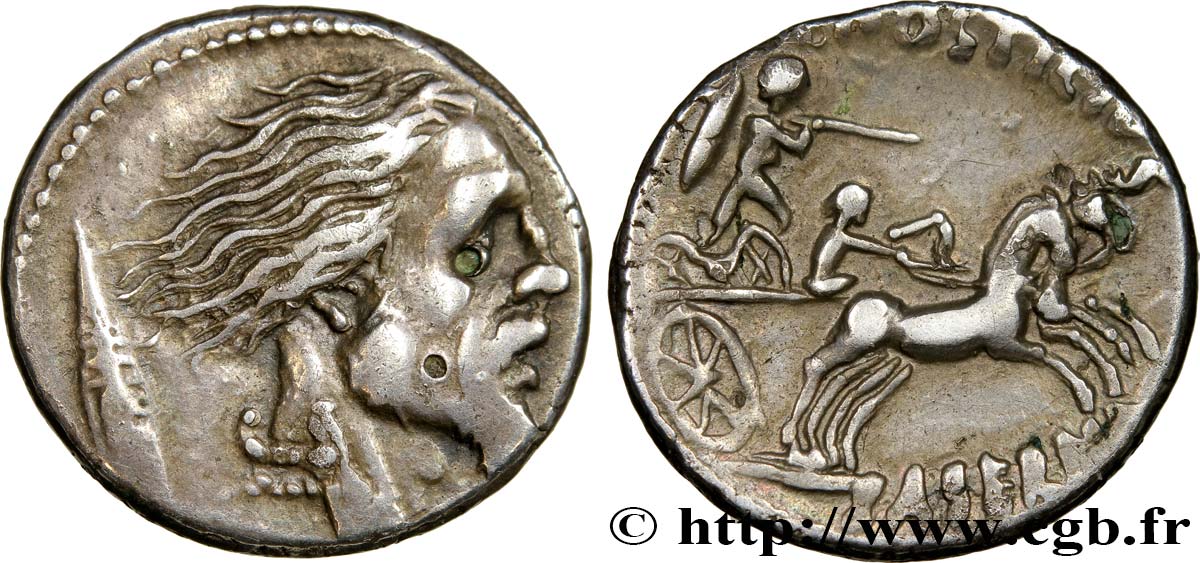
 Report a mistake
Report a mistake Print the page
Print the page Share my selection
Share my selection Ask a question
Ask a question Consign / sell
Consign / sell
 Full data
Full data